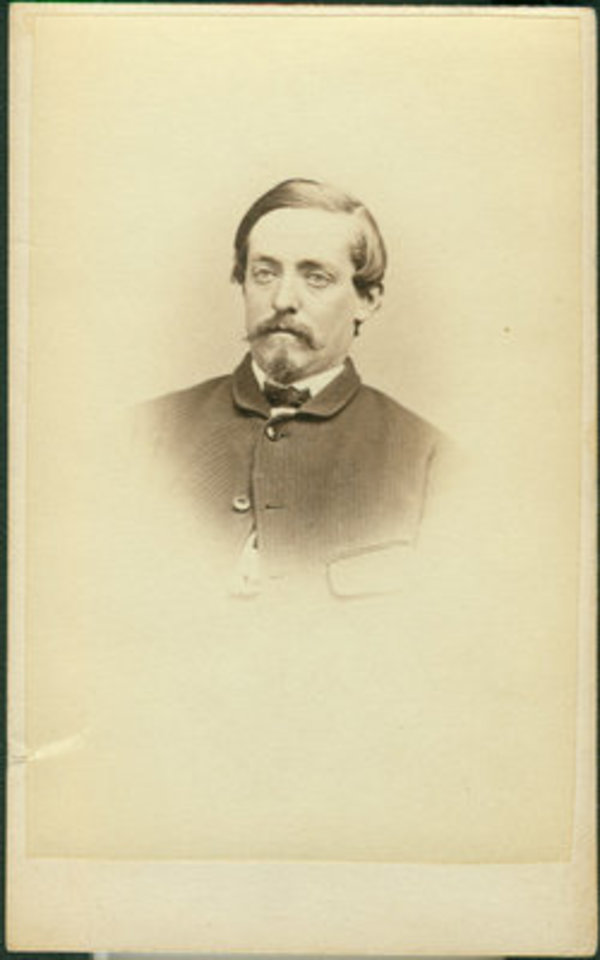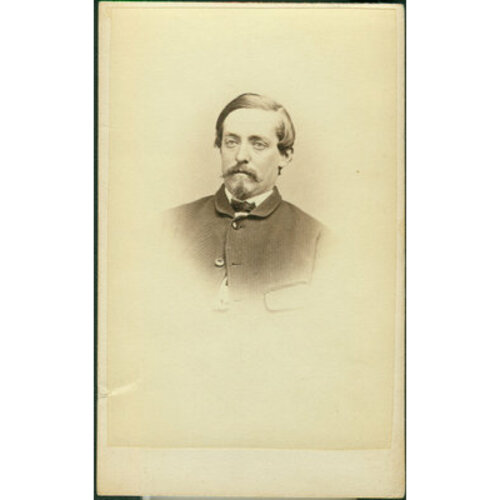
Source: Link
BRAINERD, THOMAS CHALMERS, assistant surgeon, army officer, businessman, and industrialist; b. 27 Sept. 1837 in Philadelphia, the eldest of the four children of Thomas Brainerd, a pastor, and Mary Whiting, widow of Daniel Wadsworth Whiting; m. 5 Jan. 1865 Mari Laflin Boies in Saugerties, N.Y., and they had four sons and three daughters; d. 24 April 1910 in Montreal and was buried the following day in Mount Royal Cemetery in Outremont (Montreal).
Thomas Chalmers Brainerd’s ancestor, Daniel Brainerd, a native of England, arrived in Connecticut around 1649. Thomas Chalmers spent his childhood in the presbytery adjacent to Philadelphia’s famous Old Pine Street Church, where his father officiated. In 1855, after receiving private tuition, he entered Yale College in New Haven, Conn., from which he graduated with a liberal arts degree in 1859. He studied medicine at Jefferson Medical College in Philadelphia for at least the 1859–60 academic year.
In 1861, at the start of the American Civil War, Brainerd enlisted as an officer in the Union army and became an assistant surgeon. He was posted to, among other places, Columbian College General Hospital in Washington and Broad Street Hospital in Philadelphia. As a first lieutenant in 1863, he took part in the siege of Charleston, S.C., during which he worked tirelessly to treat a large number of wounded soldiers. He was tasked with the concurrent administration of four military hospitals, including the enormous Mower U.S. General Hospital in Philadelphia. After the war (which ended in 1865), he served in Arkansas. In May 1866 he resigned his commission because of his wife’s poor health and abandoned surgery. In July the ranks of captain and major were bestowed on him, retroactive to 13 March 1865, for his loyal and commendable service.
Brainerd subsequently worked in the iron business and then in the manufacture of blasting powder. In 1867 he joined the Laflin Powder Company, whose president was his father-in-law, Joseph Milton Boies; from the position of agent, he rose to department head in 1869 and then to secretary around 1870. In 1872 he also became secretary of the board of the Gunpowder Trade Association of the United States (GTAUS), formed that year by the six largest blasting-powder manufacturers to set prices in the industry. From 1874 to 1876 he operated his own gunpowder mill near York, Penn. In 1876 the GTAUS established a subsidiary, the Gunpowder Export Company Limited, to export its surplus production to Canada and England; Brainerd was appointed president. He settled his family in Montreal that year to run the Canadian branch and would become a naturalized British subject in 1884. When the American market suddenly began to grow, the GTAUS surplus evaporated, and Brainerd realized that if he wanted to sell explosives he would have to manufacture them himself.
Together with his friend Lammot Du Pont, an American chemist and industrialist, Brainerd bought the Ontario-based Hamilton Powder Company (HPC) at the end of 1878. His father-in-law and his brother-in-law, Henry Martyn Boies, also acquired shares. Brainerd became president and Du Pont a director. The company, whose head office he quickly transferred to 61 Rue Saint-François-Xavier in Montreal, had two factories in Ontario: one for black powder in Cumminsville and one for nitroglycerin near Kingston. Nitroglycerin enabled the owners to manufacture dynamite. This powerful explosive, invented by the Swedish chemist Alfred Nobel, was considered safe because it withstood shocks and required a separate detonator. In 1877 the HPC had acquired the Windsor Powder Company of Windsor Mills (Windsor), Quebec. Towards the end of 1883 it would purchase the Acadia Powder Company of Halifax, a move to take control of a troublesome competitor.
Brainerd was now in a position to respond to the growing demand for explosives brought about by the construction of the Canadian Pacific Railway and other railways, the enlargement of the Lachine Canal, and the exploitation of mines (including those in Quebec, such as the asbestos mine in Thetford Township (Thetford Mines) [see James King*] and the copper mine in Eustis). Demand for explosives also came from sports hunters, land-clearers, police forces, and the military. To satisfy all these customers, Brainerd decided in 1878 to build a new factory in Belœil (McMasterville), which would become the most valuable asset of the HPC and would remain in business for 120 years. He chose the site, drew up plans for all the buildings, and supervised the construction. The production of black powder, nitroglycerin, and dynamite began in 1879.
When Du Pont died in 1884 in an explosion at the nitroglycerin factory of his Repauno Chemical Company in Gibbstown, N.J., Brainerd bought all the shares of the HPC owned by the estate of his loyal friend, as well as those of his father-in-law and brother-in-law. He therefore became sole proprietor of the firm, whose share capital would reach $300,000 in 1896 and then $1 million in 1899.
On 9 Oct. 1884 three consecutive explosions partially destroyed the Cumminsville factory. Fortunately, they occurred during the mid-day break, with the result that only 5 of the 200 employees perished. After the plant was closed down, production of black powder was moved that same year to Windsor Mills. Several other fatal accidents would occur in these powder mills.
In January 1886 Brainerd and four partners, including the future Liberal-Conservative prime minister John Joseph Caldwell Abbott* and the Conservative senator John Hamilton*, founded the Dominion Cartridge Company Limited with share capital of $100,000. The enterprise, housed in the former Pacific Powder Mill in Chatham (Brownsburg-Chatham), was to specialize in the manufacture and sale of cartridges, shells, torpedoes, and various articles of wrought brass. Brainerd was its first general manager and later, in 1888, its president. The head office was in Montreal, in the same location as that of the HPC. The Dominion Cartridge Company Limited, which obtained its supplies from the HPC, dominated the ammunitions market in Canada. The Bradstreet credit agency would gradually upgrade its rating, from C (good) in 1888 to A (very high) in 1910, the year it placed a value on the company’s financial resources of between $300,000 and $400,000. In 1890 Brainerd established a powder plant in Nanaimo, on Vancouver Island, his first in the Canadian west.
In 1900 the Nobel-Dynamite Trust Company of London acquired a stake in the HPC. With this transaction Brainerd wanted to obtain help for the research and development of explosives. Eight years later about a dozen specialized workers from the Ardeer factory in Scotland joined a handful of compatriots already working at the Belœil powder mill. Their expertise was needed to launch the production of new explosives, such as gelignite, mechanize the manufacturing processes for dynamite, and train the local employees. Productivity and safety were improved, an outcome that was to prove very valuable during World War I, when the great demand for explosives by allied military forces would have to be met.
In 1904 Brainerd was partially paralysed by a stroke. He then turned over the presidency of the HPC to his eldest son, Dwight. Although he retired, Brainerd remained on the board of directors until his death in 1910. That year, according to Bradstreet, the company had over $1 million in financial assets and an AA (uncontested) credit rating. In 1911 it was sold to Canadian Explosives Limited, which had received its letters of patent on 18 Nov. 1910 with share capital of $15 million, and merged with the Dominion Cartridge Company Limited, the Acadia Powder Company, the Ontario Powder Company, Standard Explosives Limited, Western Explosives Limited, and the Victoria Chemical Company. In 1927 Canadian Explosives Limited became Canadian Industries Limited, whose diversified output would easily surpass that of explosives and which is still in operation at the beginning of the 21st century.
When he arrived in Montreal in 1876, Thomas Chalmers Brainerd had set himself very lofty goals. He reached them brilliantly through his abilities as a far-sighted and efficient administrator, while at the same time engaging in formidable competition. As a Canadian explosives magnate, he made his mark for over 30 years. After his death his four sons (Dwight, Henry Boies, Winthrop, and Herbert Whiting) worked in the same sector.
During the preparation of this biography it was not possible to consult the archives of the Hamilton Powder Company.
FD, American Presbyterian Church, Montreal, 24 April 1910. Library and Arch. Can., “Citizenship registration records for the Montreal circuit court (1851–1945)”: www.bac-lac.gc.ca/eng/discover/immigration/citizenship-naturalization-records/citizenship-montreal-1851-1945/Pages/search.aspx (consulted 30 March 2017); R233-37-6, Que., dist. Montreal (175), subdist. St Antoine Ward (A): 16. Le Courrier de Saint-Hyacinthe (Saint-Hyacinthe, Québec), 20 juill. 1901. Daily Leader (Eau Claire, Wis.), 11 Oct. 1884. La Presse, 2 avril 1890, 30 janv. 1891, 17 juill. 1901. Toronto Daily Mail, 10 Oct. 1884. Maurice Auclair, “Belœil, berceau de C.I.L.,” Soc. d’Hist. de Belœil-Mont-Saint-Hilaire, Cahiers d’hist. (Belœil, Québec), no.1 (1980): 19–22. Bradstreet’s commercial reports, 1888–95, 1906, 1910–12. L. A. Brainard, The genealogy of the Brainerd-Brainard family in America, 1649–1908 (3v., [Hardford, Conn.?], 1908), 1. [Dwight Brainerd], Ancestry of Thomas Chalmers Brainerd (Montreal, 1948). Catalogue of the officers and students in Yale college (New Haven, Conn.), 1855–59. Catalogue of the trustees, professors, and students of the Jefferson Medical College of Philadelphia (Philadelphia), 1859–60. Catalogus senatus academici … in collegio Yalensi … ([New Haven], 1880). J.‑R. Cloutier, “Thomas Chalmers Brainerd et la poudrière de McMasterville,” Soc. d’Hist. de Belœil-Mont-Saint-Hilaire, Cahier d’hist. (Mont-Saint-Hilaire, Québec), no.102 (2013): 3–32. G. V. Henry, Military record of civilian appointments in the United States Army (2v., New York, 1869–73), 1: 58. A history of chemistry in Canada, comp. C. J. S. Warrington et R. V. V. Nicholls (Toronto, 1949). H. H. Lank et E. L. Williams, The Du Pont Canada history (n.p., 1982). J. H. Maule, “McMasterville, évolution explosive,” Soc. d’Hist. de Belœil-Mont-Saint-Hilaire, Cahiers d’hist. (Belœil), no.2 (1980): 25–33. U.S.A., Senate, Journal of the executive proc. (Washington), 14 July 1866; Journal of the proc. (Washington), 5 Aug. 1861. A. P. Van Gelder and Hugo Schlatter, History of the explosives industry in America (New York, 1927).
Cite This Article
J.-Roger Cloutier, “BRAINERD, THOMAS CHALMERS,” in Dictionary of Canadian Biography, vol. 13, University of Toronto/Université Laval, 2003–, accessed May 19, 2025, https://www.biographi.ca/en/bio/brainerd_thomas_chalmers_13E.html.
The citation above shows the format for footnotes and endnotes according to the Chicago manual of style (16th edition). Information to be used in other citation formats:
| Permalink: | https://www.biographi.ca/en/bio/brainerd_thomas_chalmers_13E.html |
| Author of Article: | J.-Roger Cloutier |
| Title of Article: | BRAINERD, THOMAS CHALMERS |
| Publication Name: | Dictionary of Canadian Biography, vol. 13 |
| Publisher: | University of Toronto/Université Laval |
| Year of revision: | 2021 |
| Access Date: | May 19, 2025 |



